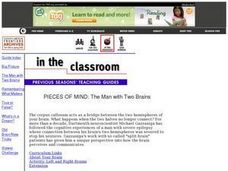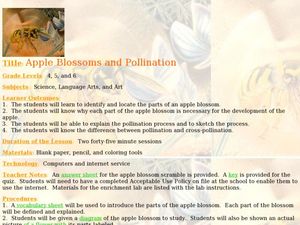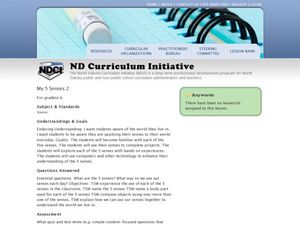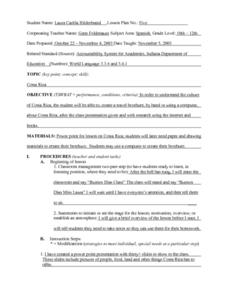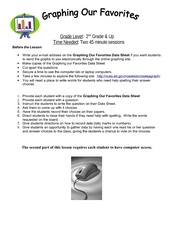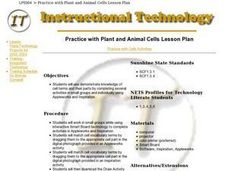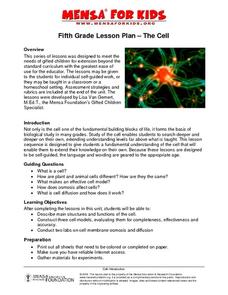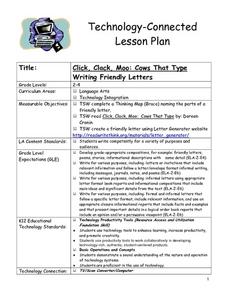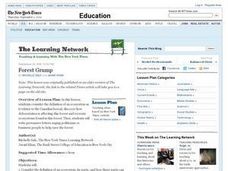Curated OER
Left and Right Brains
Students research the part of the brain known as the corpus callosum. The part of the brain that connects the left and right brain, students investigate its functions and how data passes from one side to another.
Curated OER
Apple Blossoms and Pollination
Students explore the concept of pollination. In this pollination lesson, students examine the parts of an apple blossom and then compare and contrast pollination and cross-pollination.
Curated OER
How does Your Province Stack Up?
Learners investigate data about age, and sex of a population. For this statistics lesson, students are given data on a population to analyze and compare to other provinces. This assignment is part of a geography lesson and requires 3...
Curated OER
My Five Senses 2
Students investigate the five senses. In this five senses lesson, students answer essential questions about the use of the five senses as they interact with their environment. They use a computer software program to make a concept web...
Curated OER
French Fry Run
Student explore estimation and measurement. In this measurement lesson, 2nd graders measure french fries, graph their data, and determine the size of french fries that is the best value. Students practice how to add prices and calculate ...
Curated OER
Aerobic and Anaerobic Conditioning
Students view the A.D.A.M. computer simulation of aerobic and anaerobic exercise. They break into groups and members brainstorm and list as many aerobic and anaerobic exercises as possible in five minutes.
Curated OER
It All Starts With a Seed
Students use laboratory equipment safely. They identify structures in a seed. They distinguish between monocots and dicots. They search for information using the computer.
Curated OER
Learning About the Equator, The Seven Continents and the Four Oceans
Students use a globe or map to locate the equator, oceans and continents. Using the internet, they spend time surfing through predetermined websites on continents and oceans. They write facts on different parts of the globe on index...
Curated OER
Accountability System for Academics
Students explore, analyze and study the culture of Costa Rica and create a travel brochure, by hand or utilizing a computer, about Costa Rica. They complete their brochures and present them to their classmates and then turn them in for...
Curated OER
Fantasies and Myths
Fourth graders listen to the book, THE GIVING TREE and discuss what genre category they believe the story fits into and why. They read of of the myths on the website on the computers and then come back together as a group and discuss...
Curated OER
The Android Factory
Students explore the idea that primitive virtual 3D objects can be reshaped to infinitely original combinations using additive and subtractive methods. They create 3-D objects with a computer which necessitates a cooperation of...
Curated OER
Show Me That You Understood What You Just Read
Students complete reading comprehension activities for the book Corduroy. After reading independently or in pairs, students answer questions orally as a class. They retell their favorite part of the story with the instructor and...
Curated OER
Infectious Diseases
Eighth graders identify and explain how infectious diseases effect organ systems. Using an analogy with automobiles and body systems, they discover how one part influences the operation of the whole. Students write paragraphs about...
Curated OER
Macbethan Art
Students review and reproduce an article of Elizabethan styled clothing as a part of an analysis of Shakespeare's Macbeth. In this Elizabethan art lesson, students discuss the fashion of the Elizabethan era and research it online....
Curated OER
Graphing Our Favorites
Second graders use a computer program to follow directions and graph their favorite things into a bar graph. In this graphing lesson plan, 2nd graders have 30 choices of favorite things to graph.
Curated OER
Arthur's New Puppy Directed Reading Lesson (Elementary, Reading/Writing)
Students listen and take part as teacher and classmates give a definition and examples of responsibility, then brainstorm what Arthur needs to do to prepare for his puppy's arrival. The story be read as a total group and then talked about.
Curated OER
Practice with Plant and Animal Cells
Students work in small groups to match cell vocabulary terms to the appropriate cell part in a photograph. They use a draw program to sketch a plant and animal cell.
Curated OER
Jammin' to Jazz
Students identify integral parts of jazz music by listening to Quincy Jones' We Be Doin' It. They note the bass and drum sounds, scat solos, and also sing parts of the ostinato and chorus.
Curated OER
Circulatory System Design
Students identify the different parts of the circulatory system and their function. They work together to create their own model of the system and use it to determine the rate of blood flow. They answer questions related to their model.
Curated OER
The Cell
Tenth graders explore the parts of a cell. In pairs, classmates construct a model of a eukaryotic cell, detailing its morphology and function. With the use of computer technology, 10th graders create cell book for middle schoolers. ...
Curated OER
Cows That Type Friendly Letters
Students engage in a instructional activity that introduces the parts of a letter. The instructional activity is taught using a powerpoint presentation with the purpose of integrating technology into instruction. Students create a letter...
Curated OER
Forest Grump
Young scholars consider the definition of an ecosystem, its parts, and how these parts can be affected when the ecosystem is endangered. They examine dangers being faced by the Canadian boreal forest by reading "For Billions of Birds, an...
Curated OER
Respiratory System
Students identify the parts of the respiratory system and how they interact. They define vocabulary words and draw an outline of themselves and label the parts of the respiratory system. They distinguish between healthy and unhealthy...
Curated OER
Stop the Bleeding
Learners explore various parts of the heart and blood vessels . They begin with an overview of the components of the cardiovascular system. They see a cross section of an artery and watch how a blood clot develops.
